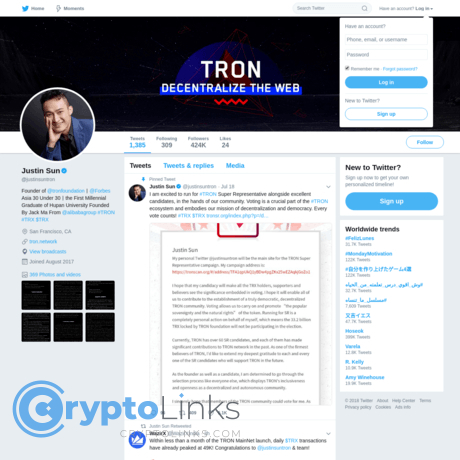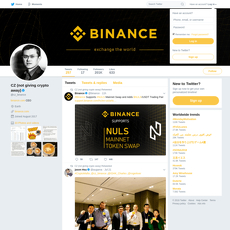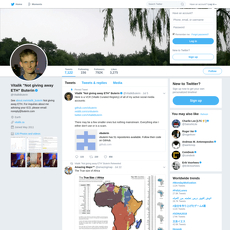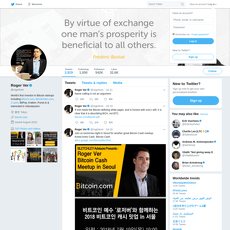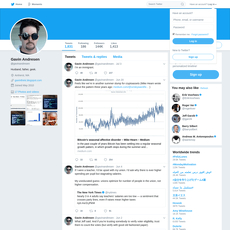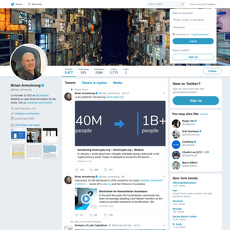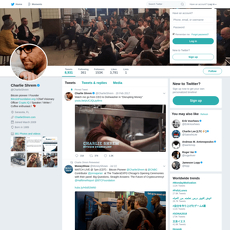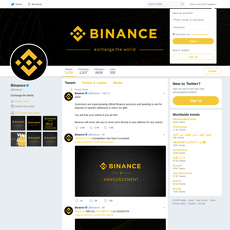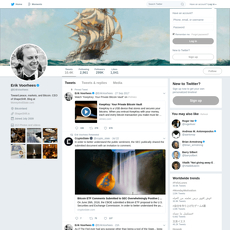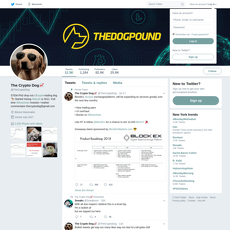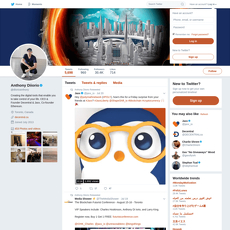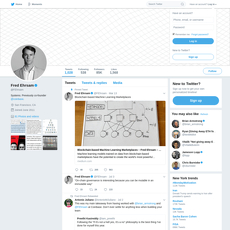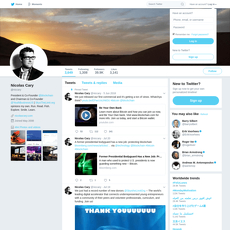Justin Sun Review
Justin Sun
twitter.com
Justin Sun (@justinsuntron) review guide: what to watch, what to skip, and answers to your biggest questions
Ever scroll Justin Sun’s X feed and wonder what’s real signal vs pure hype? You’re not alone. Between TRON milestones, HTX and Poloniex promos, BitTorrent mentions, stUSDT updates, and the occasional “big news soon,” it’s tough to tell what deserves your attention—and what’s just noise.
What makes following Justin useful—and frustrating
Here’s the reality: Justin posts fast, often, and across multiple projects. That mix can be a superpower if you’re tracking listings, integrations, and incident updates. It can also be a time-sink if you’re chasing vague teasers, giveaway threads, or screenshots without links.
Real-world examples I’ve seen:
- Listings or integrations announced first on X: These can hint at near-term moves, especially when they name a specific token, exchange, or product. The trick is verifying with the partner’s official account before acting.
- On-chain stats and milestones: TVL, transactions, addresses—sometimes posted with slick graphics. Useful if you can match them to public dashboards or explorers.
- Crisis or security notes: Exchange incidents, redemptions, or migration plans often start as short threads. In those moments, his posts can be the fastest way to get timelines and links to support or status pages.
- Giveaways and “stay tuned” posts: Engagement candy. They spread quickly—and attract scammers who spoof domains or handles in replies.
If you’ve ever felt whiplash trying to sort urgent from promotional, you’re exactly who I wrote this for.
The problem most people run into
You get a rapid-fire feed and no simple way to prioritize. You skim, open a dozen tabs, and still can’t tell what’s actionable. Meanwhile, scammers pile into replies with fake “claim” links, bots repost old announcements, and you’re left wondering if you missed the actual update.
This isn’t just an annoyance. Influential accounts do move short-term sentiment. Academic and industry research has shown that high-profile tweets can nudge crypto markets, especially around listing or partnership news. Two quick reads worth knowing:
- Ante (2022): How influencer tweets affect crypto returns — documents short, sharp impacts around specific tweet types.
- Bollen et al. (2011): Twitter mood and markets — older, broader study, but a classic on social posts shaping short-term trading behavior.
Bottom line: separating signal from noise isn’t optional—it’s your edge.
What I promise you’ll get here
I’ll give you a simple, repeatable way to read his feed without getting sucked into distractions. You’ll be able to:
- Skim smarter: A quick filter to spot posts that actually matter to users, traders, or builders.
- Verify fast: A 30–60 second routine to confirm claims using official org accounts, blogs, and block explorers.
- Stay safe: Easy checks to avoid phishing, impersonators, and screenshot-only “announcements.”
No drama. No hero worship. Just a practical playbook so you can act with confidence—or ignore with confidence.
At a glance: signal vs. noise
This isn’t the full framework yet, but here’s how I mentally triage in under a minute:
- Likely signal: Named partnerships with links, exchange listing/delisting notices, incident updates with status pages, metrics that match public dashboards, timelines with dates and docs.
- Likely noise: “Big news soon,” giveaways without official blog links, screenshots that don’t cite sources, posts that you can’t match to on-chain or official announcements.
When you apply this light filter, you’ll catch the posts that move users and markets, and you’ll ignore the stuff that eats your time.
Who this is for
- Traders: You want early, verified hints on listings or integrations without chasing bait.
- Builders: You care about ecosystem changes—fees, TVL, yield products, migrations—that affect users.
- Researchers and journalists: You need a clean workflow to confirm claims and quote official sources.
- Curious followers: You enjoy the updates, but you don’t want to get tricked by impersonators or hype.
“Treat any single post as a starting point, not the finish line. If it matters, there will be matching proof—an official org post, a partner confirmation, or an on-chain record.”
Ready to make sense of the feed without wasting your weekend? Next up, I’ll break down what roles Justin actually holds today, how far his reach extends across TRON, HTX, Poloniex, and BitTorrent—and why that context changes how you read every post. Curious which topics from him are most likely to affect users right now?
Who Justin Sun is today: roles, reach, and why his X account matters
Justin Sun sits at the center of several high-traffic crypto lanes. He founded TRON, is publicly linked to HTX (formerly Huobi) and Poloniex, and remains associated with BitTorrent (BTT) after TRON’s acquisition of BitTorrent Inc. He’s known for fast, frequent announcements, high-visibility partnerships, and very public negotiations. He also previously served as a diplomat to the WTO for Grenada, which helps explain why he stepped back from day-to-day TRON operations while still acting as a loud amplifier for the ecosystem.
I watch his X account because it often functions like a live newsroom for TRON-linked updates, exchange actions, and incident responses. Posts can create immediate ripple effects across users, liquidity providers, and token markets—useful if you want to be early, risky if you don’t verify.
“In fast markets, the first truth you confirm beats the hundred rumors you chase.”
What he talks about most
His feed clusters around a few repeatable themes. When I skim, I expect these:
- Ecosystem updates: TRON core metrics (accounts, active addresses, fees), USDD and stUSDT updates, and protocol changes around SUN/JustLend. For example, he often posts network milestones with links to explorers like TRONSCAN.
- Exchange listings and promotions: Announcements tied to HTX and Poloniex—new markets, campaign boosts, or maintenance notes. Listing posts can precede short bursts of volume on smaller caps, so I flag them but wait for confirmations.
- Chain metrics and bragging rights: Total value locked (TVL), transaction counts, USDT on TRON vs other chains. Independent dashboards like DefiLlama’s TRON page are helpful to verify any big number claims.
- Crisis comms: Hacks, outages, redemptions, migrations. During the Poloniex 2023 incident, for instance, posts about reimbursement and recovery steps hit his feed quickly and were echoed by the exchange accounts.
- Macro and policy takes: Commentary on adoption, regional policy, and crypto’s direction. These set tone and context, even if they’re not directly actionable.
Why people follow him
Three reasons stand out for me:
- Potential alpha: Early hints on listings, integrations, and liquidity shifts across TRON, HTX, Poloniex, and BTT.
- Faster incident clarity: When something breaks, his posts can be among the first high-signal breadcrumbs—useful for risk decisions while you wait for full reports.
- Centralization of updates: He’s a single feed touching multiple brands. Even if you don’t trade, you’ll know when to pause deposits/withdrawals or watch for network changes.
There’s data to support why this can matter: multiple studies in journals like Finance Research Letters have found that social media activity and sentiment correlate with short-term crypto market movements. That doesn’t mean “buy every tweet”—it means these posts can be market-moving inputs. I treat them as signals to verify, not orders to follow.
How far his reach goes
He commands a large audience on X, and his posts are quickly picked up by crypto media, Telegram channels, and analytics bots. That “amplification loop” can turn a single announcement into action across several platforms in minutes. I often see:
- Retweet cascades from official org accounts (TRON/HTX/Poloniex/BTT).
- Rapid re-posts by market-making and listing alert bots.
- Price and volume trackers surfacing the same update within minutes.
When speed matters, that cascade is the difference between reacting with a plan and chasing noise.
Brands and responsibilities (at a glance)
- TRON: Founder; still amplifies stats, milestones, and ecosystem pushes even while not in daily ops.
- HTX: Publicly linked as an advisor and prominent figure for announcements around listings, promos, and security updates.
- Poloniex: Widely reported investor/beneficial owner; uses X for security and reimbursement messaging during incidents.
- BitTorrent/BTT: TRON acquired BitTorrent Inc.; BTT updates and integrations appear periodically in his feed.
- Diplomatic background: Previously represented Grenada at the WTO, which coincided with stepping back from day-to-day TRON management.
Communication style: bold, fast, promotional
Expect teasers, large numbers, and cross-promotion between TRON, HTX, Poloniex, and BTT. It’s part marketing, part live-ops. That’s useful—if you pair it with verification:
- Teasers: “Big partnership” hints often precede official docs by hours or days.
- Numbers-first: TVL, addresses, or “users served” claims usually arrive before the dashboard links.
- Crisis tempo: During incidents, updates come in short, frequent bursts—good for timeline building, but always cross-check with the official org accounts.
When his posts are most useful for me
- When he mentions a named partner with a link to a blog or official handle I can verify.
- When there’s a clear timeline for listings, migrations, or redemptions.
- When exchange status updates appear on his feed and on the exchange status page within a short window.
- When on-chain data is checkable via explorers or dashboards I trust.
Curious which kinds of posts I ignore, which ones I prioritize, and how I verify everything in under a minute? Keep going—next up is the simple filter that saves me hours while catching the real signals.
How to read @justinsuntron for actual signal (and skip the noise)
Justin’s feed can feel like trying to drink from a firehose. I don’t try. I run every post through a tight filter that catches real updates and drops the fluff. Think of it as a “signal scanner” you can use in under a minute—fast enough for traders, clear enough for builders, and safe enough for anyone who’s tired of getting baited by teasers.
“Trust, but verify.” In crypto, speed is a tax; precision is alpha.
Posts that usually matter
When I see these, I slow down and verify, because they can actually change user outcomes or move markets:
- Named partnerships or integrations — If he tags a specific team/product and the partner account posts a matching announcement, that’s a strong tell. Example pattern: he tags a protocol, links an official blog, and the partner mirrors it within an hour.
- Listings or delistings on HTX/Poloniex — Listings can spark short-term volatility. I look for the HTX or Poloniex announcement page link with trading pairs, timelines (UTC), and deposit status.
- On-chain stats with dashboards — TRON TVL, addresses, or transactions backed by sources like TRONSCAN or DeFiLlama. If the numbers have a public dashboard, I pay attention.
- Crisis updates — Hacks, freezes, migrations, or redemptions. In past exchange incidents (think Poloniex 2023), his posts came with reimbursement notes and timelines that later matched official status updates.
- Concrete timelines + official docs — Real signal usually includes a date/time, a link to a blog/docs page, and clear next steps for users. Vague words without links are yellow flags.
Posts to treat with caution
- “Big news soon” — Hype can run ahead of facts. A 2018 Science study found false news spreads faster than truth on social platforms. Teasers without names, dates, or docs aren’t tradable facts.
- Giveaways or airdrops — Always check the URL and cross-verify on official org accounts. Impersonators rely on speed and FOMO. Never connect a wallet from a link in replies.
- Screenshots without links — Mock-ups and “insider charts” aren’t sources. If it’s real, there should be a blog, a repo, a contract, or a partner post.
- Claims you can’t verify — If it touches funds, liquidity, or listings and you can’t confirm it on-chain or via a matching announcement, treat it as noise.
One more reason to be picky: a well-cited 2016 analysis reported that 59% of links shared on social media were never clicked—people share headlines without reading. Source: Washington Post coverage of an INRIA/Columbia study. Don’t be that stat.
A simple filter I use in under 60 seconds
- Source — Is the post from @justinsuntron and does it include an official domain (trondao.org, htX.com, poloniex.com, bttc.bittorrent.com, sun.io)? Misspellings are an instant no.
- Second source — Do matching posts exist from the official org or the named partner? No second source, no action.
- State change — Does this actually change something a user can touch today (listing live, contract deployed, redemption open, migration started)? If yes, escalate to full verification.
I call it the 3–2–1 rule for high-impact posts:
- 3 confirmations — Justin + org + partner
- 2 neutral reads — Analytics or status pages that aren’t part of the marketing blast
- 1 on-chain proof — A tx, contract, or dashboard showing the change
Verification checklist (copy this)
- Official org accounts — @trondao, @HTX_Global, @Poloniex, @BitTorrent
- Blogs/docs — trondao.org/blog, HTX announcements, Poloniex support, BitTorrent Chain, SUN/stUSDT
- On-chain — TRONSCAN for contracts, supply, and txs; if bridges are involved, check the corresponding explorer too
- Analytics — DeFiLlama for TVL and protocol share, plus reputable dashboards from research firms you already trust
- Status/incident pages — Exchange or project status/incident logs; during events, these usually update before social posts catch up
Timing: when it’s smart to wait
- Weekend/late-night teasers — Lower liquidity hours can exaggerate moves. I wait for the Monday blog or the full PDF/docs unless there’s real user impact right now.
- “Buy the rumor, sell the news” windows — If a post hints at a listing or integration “next week,” I set alerts, not market orders. The first move isn’t always the best move.
- Cooldown timer — After a flashy post, I force a 15-minute cool-off to check partner feeds, announcements pages, and explorers. If it still looks good after that, I proceed.
Smart alerts and watchlists (so you don’t stare at X all day)
- Create a dedicated List — Justin + TRON/HTX/Poloniex/BitTorrent official accounts. Keep the list clean—no memes or fan pages.
- Save advanced searches — Example: from:justinsuntron (listing OR integration OR mainnet OR hack OR redemption OR migration). Pin it in your client.
- Mirror with RSS/email — Subscribe to project blogs and exchange announcement feeds. Let real docs ping you.
- On-chain alerts — Set notifications for key contracts or supply changes on TRONSCAN or your preferred explorer tools.
Green vs yellow vs red flags
- Green — “HTX will list XYZ at 12:00 UTC” + official blog link + partner confirmation + trading pairs and deposit timelines. I verify pairs on the exchange and set a watch, not a knee-jerk trade.
- Yellow — “Major partnership coming next week” with no partner named. I set calendar alerts and wait for the org post.
- Red — “Claim your airdrop” with a lookalike domain or a link from replies. No second source, no docs, wallet connect required. Hard pass.
If you’ve ever FOMO’d into a teaser only to watch it fade, you know the sting. The fix isn’t to move slower—it’s to move smarter. Want a fast way to triage the kinds of posts he makes, bucket by bucket, so you can set pinpoint alerts and skip the rest? Next up, I break his feed into the main themes you’ll see—curious which ones are actually actionable?
Content breakdown: the main themes on Justin’s feed
If you’ve ever opened X, scrolled five seconds, and felt overwhelmed by the firehose, you’re not alone. The trick is knowing the buckets Justin posts into—and training your brain to sort them fast. That’s how I skim for signal without getting pulled into hype or reply-chains.
“Noise is a tax on attention. Pattern is your rebate.”
Product and ecosystem updates
This is where he tends to amplify what’s shipping and what’s growing—useful for anyone tracking user impact, yields, or liquidity shifts.
- TRON core metrics: You’ll often see numbers on addresses, daily transactions, fees burned, or TVL. When he shares big round numbers, I cross-check with TRONSCAN and dashboards like DeFiLlama (TRON).
- Stablecoin and yield notes: Mentions of USDD or stUSDT, and components like SUN/JustLend (e.g., APR tweaks, collateral updates, emissions). These can change lending rates or LP returns. I keep quick links handy to Sun.io and JustLend to verify.
- BitTorrent ecosystem: Updates around BTT, storage, or streaming tie-ins usually show up as integration or scaling notes. If there’s a technical claim, I look for a blog post or repo link before I act.
What I watch for: concrete numbers + links to official dashboards. Screenshots without sources go into my “wait and see” bucket.
Why it matters: Growth posts can foreshadow fee changes, liquidity rotations, or farm resets. If he flags a parameter change (like LTV or emissions), that’s actionable for risk and yield.
Exchange and listing news
Listings, pairs, promos, and security statements for HTX and Poloniex. These posts can move markets in the short term and are fertile ground for scammers—so stay sharp.
- Listing anatomy: Typical phrasing is “Deposits open at [time], trading at [time], pairs: [XYZ/USDT], fees or rebates.” I confirm on the official exchange account and the HTX announcements or Poloniex announcements pages.
- Why traders care: Event studies (industry and academic) have shown short-term volatility and volume spikes around listings. The “listing effect” is real—but inconsistent. One example analysis is Messari’s look at the Coinbase effect; the broader lesson applies: expect heat, manage slippage.
- Security/ops posts: Wallet maintenance, reopen schedules, or reimbursement plans. Always match these with exchange status pages or status updates, not third-party links in replies.
Tip: When a listing pops, I set a temporary alert for the token on my price app, then check liquidity depth and spreads before touching anything. Hype is expensive if your exit’s thin.
Market and policy commentary
High-level takes on adoption, regulation, and regional momentum. These rarely require immediate action, but they shape expectations.
- Adoption snapshots: Mentions of stablecoin usage, remittances, or developer growth. I contextualize with outside references like the Chainalysis Global Crypto Adoption Index or exchange volume reports.
- Regulatory lens: Notes about Asia, MENA, or LatAm policy environments. Use these to anticipate where listings, partnerships, or fiat on-ramps might expand next.
- Macro mood: Comments during risk-on/risk-off days. For me, these are sentiment checks—not trade signals.
How I use it: I tag posts by region in a simple note. Over a quarter, patterns pop—helpful for guessing where the next partnership or event might land.
Incident response posts
When things go wrong—hacks, outages, or urgent upgrades—he usually posts fast. These threads deserve your full attention and a cool head.
- What a solid incident post looks like: a timeline, affected systems, known attacker addresses, steps taken (freezes, blacklists, pauses), partner support, and reimbursement or migration plans.
- Your move:
- Check matching statements on the official org accounts and status pages.
- Verify any on-chain claims via explorers (e.g., TRONSCAN addresses he references).
- Do not click links in replies—go direct to known domains.
- Why this matters: The earliest details are often incomplete. I screenshot the first post, then wait for the second or third update before making any big transfers or portfolio changes.
Emotional check: “Panic is a position.” In fast-moving incidents, I set a 5–10 minute timer before acting. The extra clarity pays for itself.
Community engagement and events
AMAs, Spaces, conferences, and partner summits—these posts tell you where attention is heading next.
- AMAs/Spaces: Watch for “we’ll announce [X] live” phrasing. I listen for roadmap specifics and then wait for the written post or doc for confirmation.
- Conference clusters: When he’s on stage at big shows (think Token2049, Hong Kong Web3 Festival, etc.), you’ll often see a burst of partnership photos and shout-outs. I treat these as lead indicators—proof comes when the partner posts their own announcement.
- Community drives: Hackathons, grants, or builder incentives. Great for devs and early adopters; I track the application link and deadline, then set reminders to check winner lists.
Micro-habit that works: Create a short list of official org accounts + partner candidates and subscribe to their notifications during event weeks. Cross-posts are your strongest confirmation.
Curious why he stepped back from day-to-day TRON ops, what his nationality is now, or the safest way to contact him without getting phished? I’ve got quick, straight answers next—plus whether his tweets really move markets and what that means for you.
FAQ: fast answers to popular questions about Justin Sun
I get a lot of the same questions whenever Justin Sun trends. Here’s the short, no-fluff version, with sources you can check and practical pointers so you don’t get caught by fakes.
“Trust, but verify.” In crypto, the fastest finger often loses the most.
Why did Justin Sun leave TRON?
He didn’t fully leave. In late 2021, he shifted away from day-to-day operations as TRON moved toward DAO-style governance, while he took on a diplomatic role as Grenada’s Ambassador/Permanent Representative to the WTO in Geneva. That explains long stretches where he focused on policy and international engagements, while still promoting TRON and related projects.
- Background: TRON Foundation announced a transition to community governance in 2021.
- Public profile: His WTO role has been widely reported and is reflected in public biographical sources.
What nationality is Justin Sun?
Public sources list him as Grenadian. He was born in China. This dual context shows up in his business ties and policy commentary, which often spans Asia and global markets.
How do I contact Justin Sun?
He’s active on X at @justinsuntron. Direct replies are hit-or-miss, so for anything account- or exchange-related, go through official support:
- HTX Support
- Poloniex Support
- TRON DAO (official links and docs)
Important: Don’t trust “assistants” DM’ing you first. If a message isn’t from verified org channels or the exact handle @justinsuntron, assume it’s an impersonator.
Is @justinsuntron legit?
Yes—it’s his long-standing, high-visibility account, widely referenced by official TRON/HTX/Poloniex channels. Still, the golden rule stands: verify any link he shares.
- Cross-check with official org accounts (TRON DAO, HTX, Poloniex, BitTorrent).
- If it’s a partnership, look for a matching post from the partner’s verified account.
- If it’s on-chain, confirm with explorers before you act.
Does he move markets?
He can—especially around listings, mints/burns, or big integrations. The mechanism is simple: attention and liquidity hit at the same time, and short-term moves happen.
- What I’ve seen in practice: smaller-cap listings on HTX/Poloniex sometimes spike within minutes of an announcement—then cool off just as fast once liquidity normalizes. That first 5–30 minutes can be chaotic.
- What research says: social-media-triggered price moves are real in crypto. For example, the Blockchain Research Lab found significant short-term effects from high-profile tweets on crypto prices and volumes (see Lennart Ante, 2021).
- What to do: never trade a single tweet. Wait for the official listing page to go live, check order books, and size positions like spreads can widen without warning.
Are his tweets investment advice?
No. Treat them as marketing, announcements, or negotiation signals. Your checklist should come first:
- Confirm: official org post, partner post, or signed doc.
- Check on-chain: explorer links for mints, burns, or migrations.
- Look at liquidity: if volume is thin, don’t chase speed.
- Protect yourself: verify domains, avoid reply-links, and use hardware wallets.
How do I avoid impersonators and phishing?
Scammers love big-name threads. Use these quick tells:
- Handle must be exactly @justinsuntron (watch for typos like “jus1insuntron”).
- No giveaways that ask you to “connect wallet” or “confirm seed.” That’s a hard no.
- Open links by typing known domains yourself (HTX, Poloniex, TRON DAO)—never from replies.
- When in doubt, wait for the partner’s official post or a status page update.
What kind of posts should I act on fast vs. slow?
- Fast (but verified): confirmed exchange listings, migration deadlines, redemption windows, reimbursement announcements with live status pages.
- Slow: teasers (“big news soon”), screenshots without links, “we’re in talks” posts, or anything that doesn’t have a matching official statement.
If you’re wondering how all this ties into the bigger question—risk—what about legal heat, stablecoin depegs, or exchange security incidents linked to his orbit? That’s exactly where we’re headed next. Ready for the part that can actually save your funds when things get messy?
Trust and risk: controversies, security notes, and how to stay safe
I keep up with @justinsuntron because there’s signal—but I also treat everything around his ecosystem with a sober risk lens. Here’s the reality check I use before I stake, bridge, or even click a link.
Regulatory and legal context
In March 2023, the U.S. SEC filed a complaint involving entities tied to TRON and BitTorrent, alleging unregistered offerings and market manipulation via wash trading. These are allegations, not findings—but headlines like that can hit liquidity, listings, and sentiment fast. A real-world knock-on effect: some platforms restricted or delisted related assets around that time, and U.S. venues tend to lean conservative when legal risk rises.
My personal rule here is simple:
- Assume venue risk. If you’re holding TRX, BTT, USDD, or ecosystem tokens, don’t depend on a single exchange for exits. Keep a DEX plan and a second centralized account verified and ready.
- Watch for secondary effects. Legal pressure can lead to tighter market-maker inventory, thinner books, and wider spreads. If you trade size, track order-book depth daily.
Context note: Industry research shows enforcement cycles often correlate with liquidity fragmentation and pricing gaps across venues. That’s not a comment about guilt or innocence; it’s a reminder that markets react before courts do.
Stablecoins and depegs
Algorithmic and semi-collateralized stables carry design risk. USDD, for example, has experienced peg pressure during stress events, with public market data showing periods below $1.00 during 2022–2023 volatility. If you’re earning yield in pools paired with USDD or using it as collateral, your “stable” leg can turn into a directional bet when spreads widen.
What I do:
- Track collateral and backing. Follow official dashboards and on-chain reserves. If the peg mechanism relies on another volatile asset, I haircut my position sizing.
- Check redemption mechanics. Is there a hard redemption path? Is it programmatic or discretionary? If it’s discretionary, I assume slower recovery in stress.
- Model slippage at stress points. I simulate exits at $0.98, $0.95, and $0.90 to see if my PnL still works.
On stUSDT and yield wrappers: yield-bearing tokens introduce counterparty and duration risk. If the yield comes from off-chain assets or rehypothecation, transparency and legal structure matter as much as APY. I read the docs, then assume best-case APY can be interrupted during black swan events.
Exchange and security incidents
Exchanges linked to Justin have had notable incidents—and clear public responses—over the past few years.
- Poloniex (Nov 2023): On-chain investigators traced outflows exceeding $100M from hot wallets. Public statements acknowledged the event and pledged user reimbursement, followed by phased reopenings. During events like this, withdrawals may pause and market spreads can kink.
- HTX and associated infrastructure (2023): Reported hot wallet losses in September (~$7–8M) and a later multi-asset exploit affecting related infrastructure in November. Communication ran through official X accounts and status updates, with reimbursements discussed.
None of this is unique to one brand—centralized venues and bridges are frequent targets. Industry data backs it up: Chainalysis reported roughly $1.7B stolen from crypto services in 2023, down from ~$3.7B in 2022, with cross-chain bridges remaining high-value targets. Translation: even when the total losses drop, the tail risk is still nasty.
Bridge and cross-chain risk (yes, this matters on TRON)
Bridges and custodial wrappers are failure-prone because they centralize big balances. If you hop between TRON and other chains, remember:
- Smart contract risk compounds. You’re trusting the origin chain, destination chain, the bridge contracts, and the validator set or multisig.
- Exit routes can choke. If a bridge pauses or an exchange halts withdrawals, your “liquid” plan turns illiquid fast.
- Keep a plan B route. I maintain two independent bridges and an exchange off-ramp for any asset I might need to move quickly.
Protocol risk on TRON (lending, DEXs, and governance)
JustLend, SUN, and other TRON-native protocols are central to the ecosystem. I treat them like I’d treat any DeFi stack on any chain:
- Read the audits—but don’t stop there. Audits reduce risk; they don’t erase it. Look for bug bounties and recent code commits.
- Watch oracle dependencies. Lending markets live and die by price feeds. If a feed wobbles, liquidations can misfire.
- Check admin powers. Can a multisig pause markets or change parameters? I size smaller when admin keys are powerful.
- Monitor utilization and caps. If a market sits at 90% utilization, withdrawals can stall and rates can spike at the worst time.
My safety mantra: Don’t let yield blind you to stack risk. If two or more layers (bridge + lending + algo stable) must all work perfectly, your real risk is multiplicative.
Liquidity and market structure reality
TRC-20 tokens can be concentrated across a few venues and pools. That’s fine in normal times, but during volatility it means:
- Slippage accelerates. A 0.3% fee pool can hide 2–5% impact when depth thins.
- Funding and borrow rates whip. If you’re hedging with perps, funding can flip hard and chew your PnL.
- OTC fills change quickly. If you rely on OTC, confirm quotes before you need them—not during a crunch.
Practical safety checklist
- Skip reply links. Impersonators farm replies on every major announcement. Type official domains manually or use bookmarks.
- Verify contract addresses on explorers. Cross-check on TRON block explorers and official org repos. Never trust a random screenshot.
- Use hardware wallets. Keep staking/farming funds in hardware-managed accounts. Revoke approvals monthly or after testing a new dApp.
- Split custody. Separate “trade,” “farm,” and “cold” buckets across different wallets and venues. Don’t commingle everything for convenience.
- Wait for partner confirmations. If Justin announces an integration, let the named partner publish docs before you commit funds.
- Stress-test exits. Before entering, figure out how you’d leave with size. Identify two CEX routes, one DEX route, and one bridge alternative.
- Enable 2FA the right way. Use an authenticator app or hardware key, not SMS. Add a withdrawal allowlist and a cooling period where available.
- Test with dust. First transfer is always tiny. If it fails or fees/bridges change mid-flight, you’ll be glad you didn’t send the lot.
Comms redundancy: don’t rely on a single feed
When incidents hit, official posts can lag or fragment across accounts. I keep redundant alerts on:
- @justinsuntron plus the official TRON, HTX, Poloniex, and BitTorrent accounts
- Protocol status pages and blogs for exchanges and major TRON dApps
- One analytics source for on-chain flows (to spot real movement versus chatter)
This way, if one channel is slow or compromised, I have a second source within minutes.
Resources and further reading
- Official project blogs and status pages. For policy changes, listing notes, migrations, and incident timelines.
- Block explorers and analytics. TRON explorers for contract checks; DefiLlama-style dashboards for TVL and liquidity trends.
- Industry security reports. Annual summaries from firms like Chainalysis and CertiK help calibrate risk across CEX, DeFi, and bridges.
I’ve shown you the risk map I actually use. Want the exact alert setup and my quick-verify routine that keeps the noise out while catching real opportunities? That’s up next—ready to borrow my playbook?
My verdict on following @justinsuntron (and how to make it actually useful)
I do follow him. There’s real signal in his feed, but I treat it like a live scanner—not a final source. My rule is simple: get the alert from his post, then confirm with an official announcement or on-chain data before acting. That routine has saved me time, and more importantly, kept me away from rushing into half-baked “soon” teasers.
Two things I’ve learned from watching his account closely:
- Listings and integrations can move markets—briefly. Market structure data firms like Kaiko and multiple exchange research desks have shown that listing news often sparks short-lived volume spikes and volatility. Good if you’re prepared, risky if you chase late.
- Incident posts are urgent but incomplete. They’re useful for early heads-ups (security, redemptions, migrations), but final details almost always land on official exchange/project channels. I wait for those.
“Treat tweets as the spark, not the fire.”
Who should follow (and how)
If you touch anything in the TRON orbit—or you track exchange operations—following him is worth it. Just set your filters right.
- TRON ecosystem users: Watch for USDD/stUSDT and protocol changes that affect yields, staking, or redemptions. Confirm with Tronscan and official blogs before moving funds.
- Exchange watchers: Listings, maintenance, and security notes tied to HTX and Poloniex can impact liquidity and user ops. Always cross-check status pages and help centers.
- Builders/researchers: Sometimes you’ll see early hints of partnerships or infra moves. Don’t take screenshots at face value; look for matching posts from the partner org.
For all three groups, I recommend enabling alerts only around actionable words and pairing them with official accounts to reduce noise.
Quick setup: get the benefits without the noise
- Create a focused X List: Add @justinsuntron, @trondao, @htx_global, @Poloniex, and @BitTorrent. Pin this List and skim it first.
- Use X Pro (TweetDeck) columns: Set a search column for:
from:justinsuntron (listing OR integration OR security OR hack OR redemption OR migration OR announcement OR burn OR mint)
Add matching columns for from:trondao, from:htx_global, and from:Poloniex. This gives you a second source instantly. - Mute the bait: In X settings, mute words like giveaway, airdrop, RT to win, and free. It cuts reply spam and impersonator noise drastically.
- Mirror alerts off-platform: If you live in Slack/Telegram, route account or keyword alerts there using your preferred notification tool. Keep it read-only to avoid FOMO chatter.
- Track the official pages you’ll actually use:
- Tronscan for address/token checks
- DefiLlama: Tron for TVL and protocol shifts
- Exchange help/status pages (bookmark the official URLs directly)
- Project blogs linked from verified org homepages
- Keep a one-page “verify pad” in your notes tool with:
- Official domains and socials for TRON, HTX, Poloniex, BTT
- Known contract addresses you interact with
- Explorer links for fast lookups
- Contact/support links for exchanges you use
- Adopt a 3-step verify rule:
- Source: Is the post from the verified account and does the link go to the correct domain?
- Second source: Do matching posts exist on the official org accounts or blog?
- On-chain or status: If it’s technical (mints, burns, redemptions, migrations), confirm on-chain or via the project/exchange status page.
- Crisis mode checklist: If he posts about an incident, immediately open the org’s status page, help center, and X account in new tabs. Ignore all reply links. Wait for at least one official statement with timelines before taking action.
Final take
Following him is worth it if you treat his posts as a starting point. He’s fast, he’s loud, and sometimes he’s first—but the wins come from reacting with a plan, not reacting fast.
When he hints at a listing or integration, I flag it, then I wait for the org confirmation and documentation. During security or redemption updates, I watch his thread, but I act only after the exchange or protocol publishes the exact steps. That rhythm catches the signal and keeps me out of trouble.
Use the feed to get early awareness. Use official sources to make decisions. Do that consistently, and you’ll capture the upside of following @justinsuntron without getting pulled into hype or unnecessary risk.
CryptoLinks.com does not endorse, promote, or associate with Twitter accounts that offer or imply unrealistic returns through potentially unethical practices. Our mission remains to guide the community toward safe, informed, and ethical participation in the cryptocurrency space. We urge our readers and the wider crypto community to remain vigilant, to conduct thorough research, and to always consider the broader implications of their investment choices.

